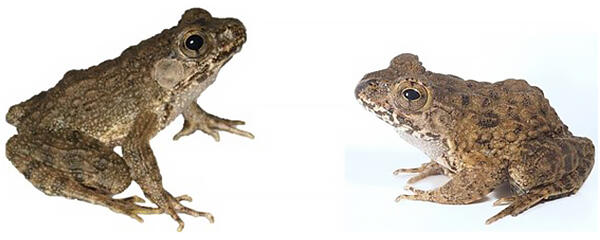A species of frog that inhabits Japan's Kanto and Tohoku Pacific regions, and was previously thought to be the Japanese wrinkled frog Glandirana rugosa, has been revealed to be a new species. The finding was revealed by a joint research team from Aichi University of Education, Kyoto University, Kitakyushu Museum of Natural History and Human History, Preservation and Research Center, City of Yokohama, Seoul National University and Hiroshima University. Their achievement fundamentally rewrites the phyletic evolution of G. rugosa in Japan. These results were published in the online edition of Zootaxa.

Provided by Associate Professor Shimada Tomohiko, Aichi University of Education
G. rugosa is endemic to Japan. It can be found from Honshu through to Shikoku, Kyushu, and the adjacent outlying islands. A closely related species, G. emeljanovi, can be found in the Korean Peninsula. In Japan, another closely related species called G. susurra, found on Sado Island, was described in 2012.
Experts had uncovered several differentiated regional groups of the globally well-known G. rugosa through mitochondrial DNA and sex chromosome type, but no full-scale genetic and taxonomic studies had been conducted.
To examine the phyletic evolution of this species group, the research group conducted comprehensive genetic and morphological analyses of frogs of the genus Glandirana that inhabit 161 locations in Japan (excluding Hokkaido), the Korean Peninsula, and Sado Island and conducted a taxonomic study of distinctive local populations.
The 161 regional populations of G. rugosa were found to be divided into two major groups based on nuclear DNA sequences (312 single nucleotide polymorphisms), consisting of the Kanto and Tohoku Pacific populations and other regional populations. The latter group showed relatively high homology to the genome of the Korean Glandirana emeljanovi. Although there were no significant differences between the two groups' external morphology as adults, the researchers found clear differences in the distribution of larval ventral glands. Given that the first description of G. rugosa was most likely in Kyushu, it was inferred that the latter group was the conventional species and that, based on genomic homology, this population was closely related to G. emeljanovi.
This suggests that the population inhabiting the area from Kanto to the Tohoku Pacific is ancient and already inhabited Japan before the arrival of G. rugosa. Furthermore, the fact that it has clear differences in genome sequence from G. rugosa and that no hybrids between the two were observed at the distribution boundary also suggests reproductive isolation. In other words, it is appropriate to describe it as a new species. The researchers named this group Glandirana reliquia or the Proto wrinkled frog, because of its genetic characteristics (relics) that came from frogs of the genus Glandirana that inhabit Japan.
The species has been present in Japan since it diverged from its ancestral population before the coming of G. rugosa. However, further investigation is required to discover which part of the continent it originated from before populating Japan. Uncovering its phyletic evolution is vital for studying the origin and evolution of other frog species in Japan, and future analysis is expected. G. rugosa are also known to be an excellent material for sex determination and sex chromosome studies due to their highly diverse sex chromosomes. G. reliquia has been shown to have had a significant genetic influence on the evolution of sex chromosomes in G. rugosa, and this finding will be vital in developing future research.
This article has been translated by JST with permission from The Science News Ltd.(https://sci-news.co.jp/). Unauthorized reproduction of the article and photographs is prohibited.




